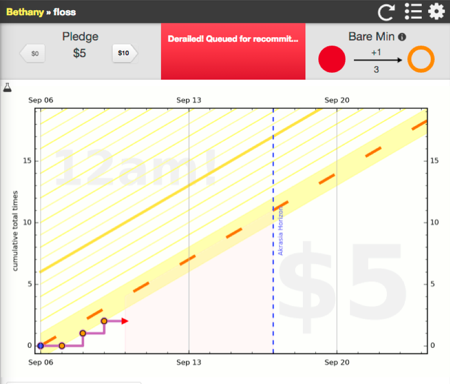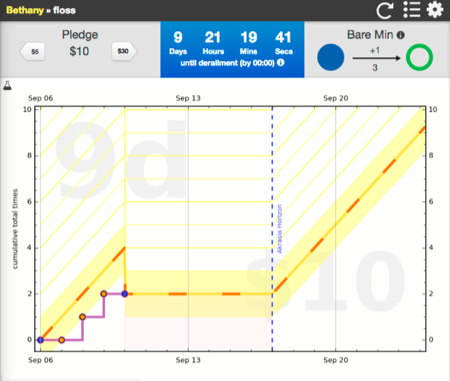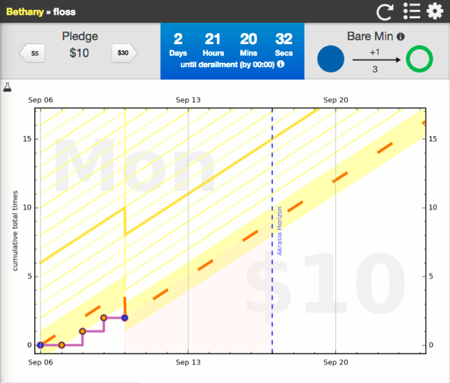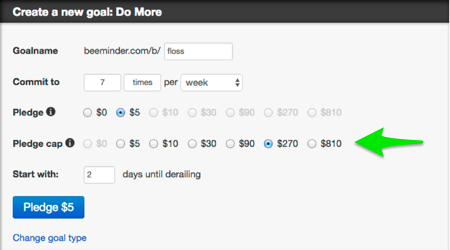
First off, what do we mean by derailing? We mean you pass your deadline — midnight by default — with today’s datapoint in the red. Here’s an example of a goal right at the end of the day. The countdown has run out, and I still haven’t done my flossing:

(Hover or long-press the graphs for more commentary.) Three things happen when you pass the deadline and you still haven’t done the thing you’re beeminding.
1. The Road Resets
We move the yellow brick road down to meet you where your latest datapoint is (or up in the case of a weight loss or Do Less goal). You also get a week of flat spot.

This is so that you aren’t stuck playing catch-up to a goal you’re already behind on. But more than that, you’ve got a week of break which you can use to take a vacation, make changes to your goal like changing the rate, or even quitting altogether. Or you can start working to keep that new safety buffer.
If you don’t want to be allowed to slack off for a week, you can check the “No Mercy Recommit” checkbox in the goal’s settings. Then your road will still jump to where you are currently, but it will continue upward at your previous rate from that point forward, with no flat week. Like this:

Again, even at its most merciless Beeminder never expects you to catch back up to the original road. Beeminder enforces daily progress and if you fall short and get stung (i.e., charged money) the slate is wiped clean and you continue from where you are.
2. You Get Charged Money and Your Pledge Increases
We charge your credit card for the amount you have pledged (usually $0 initially), and we increase your pledge to the next level. It gets expensive fast, from $5 to $10 to $30, $90, $270, $810. If $810 sounds insanely expensive to you, don’t worry! It’ll only get that high if you want it to, because once you reach an amount of money that is sufficiently motivating, you can opt out of further increases in your pledge by setting your “pledge cap”. You set your pledge cap as part of creating the goal, but you can change it in your goal settings any time you like.

Our advice is to set the pledge cap to something scary enough that you’re motivated to never let it actually get that high. But also not so scary that you’d rather quit Beeminder than have that amount at risk. The steeply exponential pledge schedule is so you quickly get to a motivating pledge with minimal wasted money on amounts that aren’t motivating enough.
3. We Send a Legit Check Email
We email you to let you know you derailed and that we are about to charge you. You can’t opt out of these emails. This is us asking if the derailment was legitimate. If you forgot to enter data, or you configured the goal all wrong, or there was something you didn’t understand, or a hurricane knocked out your power, or anything at all that you’d count as a technicality, simply reply to that email! If you say the derailment wasn’t legitimate (and say why), we’ll cancel the charge and undo the derailment. You have 24 hours to respond to the legitimacy check before the charge goes through! (We can refund a charge that’s already gone through, if you had an emergency and couldn’t respond in time, but that’s more of a pain for both you and us, as you can imagine.)
If you want us to hold you to a higher standard you can check the Weaselproof me box in the goal’s settings. Then we might ask for additional proof of your exceptional circumstances, such as a snapshot of you with your doctor, or a tweet or other public announcement of your excuse, for example. In other words, if your goal is weaselproofed then we won’t just blindly believe you that the derailment didn’t count.